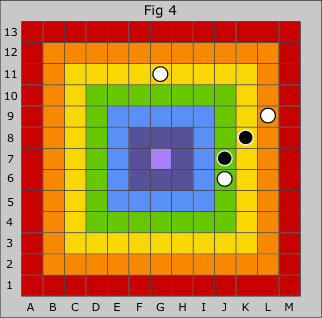 | Equipment The board is coloured in the concentric manner of a square archery target, with the successive shades of the rainbow: Red through to Violet. The centre square is called the Throne.
Setting up At the beginning of the game, Black and White have 24 pieces each on the board. These are randomly disposed on the outermost band, with the sole proviso that every piece must have a piece of the adverse colour diametrically opposite (Fig 1). At Mindsports a set-up will be generated automatically unless players decide otherwise. Face to face, it is arrived at as follows: Black places, anywhere on the outermost band a black piece and a white one will automatically appear diametrically opposite. Then White places two such pairs, after which the players alternately proceed placing two pairs until the border is filled. Neither King is on the board at start of play. |
Play Morelli interactively
Winning
At the start of the game the Throne is vacant, but it may in the course of play be occupied by either King. Once occupied, it may subsequently change hands any number of times from Black to White or vice versa. The winner is the player whose King is on the Throne at the moment when the game ends. If the Throne remains vacant from start to finish, the game is drawn.
Moving
Black moves first afrer which players take turns to move one piece of their own colour. A piece may move any distance and in any direction along an orthogonal or diagonal line, subject to the following conditions:
 |
|
  |
Capturing Capture in Morelli is custodial capture, that is, it takes place when a moving piece comes to rest next to an adverse piece whose immediate neighbour on the opposite side, either orthogonally or diagonally, is a piece also belonging to the mover. In Fig 3 the black piece at D1 would capture the white piece at B4 by moving to B3, or the one at E3 by moving to D2. If it moved to I6, six white pieces would perish at one fell swoop.
|
 | Completing a frame A frame is an arrangement of four pieces, all belonging to the same player, and
A frame may be completed by a move in various ways – namely:
Thus, in Fig 5, the Black move E3-D4 completes a frame at the Green corner. E3-E4, on the other hand, completes, by capture, a different and less obvious Green frame. And, spectacularly, the White move B7-F7 conjures an Indigo frame out of thin air by adding three corners at a stroke. |
As with capture, the completion of a frame must be the immediate result of an active move during open play, hence no frames can be formed on the outermost band.
Occupying the Throne
- Where a player’s move completes a frame, he must, as part of the same turn, enthrone his King, evicting his opponent’s if applicable.
- Where the mover’s King already occupies the throne, no action results from the completion of a frame.
Ending
The game ends when either player, on his turn, has no legal move – or at any earlier moment by agreement between the players.
|
External links Morelli © Richard Moxham | ||||||





